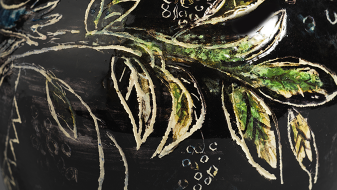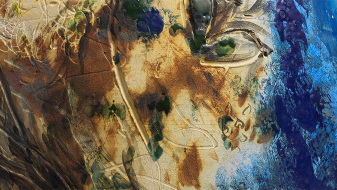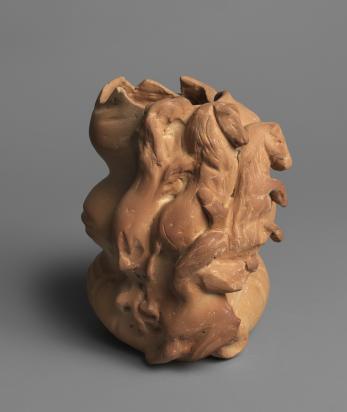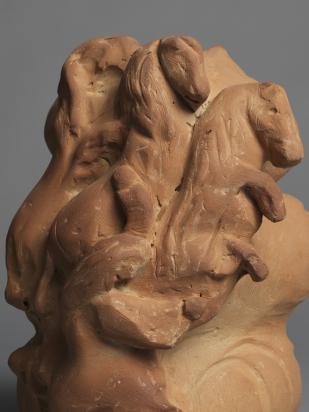In 1951, Chagall made his first vases, including two versions of Elijah’s Chariot. These pieces were the precursors of what the artist called his “sculpted vases”1, such as those in the Lovers and the Beast series (1957).
Franz Meyer called Chagall’s ceramics “physical volumes that led the painter to sculpture in the strict sense of the term.”2 Devoid of decoration and polychrome, the first version was almost certainly a terracotta proof. While the utilitarian aspect is still perceptible in the other variant, here the treatment of the raw clay by adding material and modeling might suggest a high-relief sculpture.
The theme is further revealed in the second, enameled version featuring black and ochre tones. Elijah's ascent on a chariot of fire is recounted in the second Book of Kings.3 The iconography of this biblical story dates back to the ancient figure of “Helios-Apollo”4 and later reappeared in early Christian and Byzantine art. Already the subject of Novgorod school icons,5 the fiery ascent of the prophet Elijah6 became increasingly popular in Russia from the 18th century onwards.7 It is hardly surprising, then, that Chagall, who drew inspiration from the art of the icon,8 chose this theme for his ceramics, a new medium allowing him to give the subject volume and strength. The artist chose the same subject, but on a monumental scale, for his The Prophet Elijah, or Elijah’s Chariot, Musée national Marc Chagall, Nice [Le Prophète Élie ou Le Char d'Élie, Musée national Marc Chagall, Nice] (1970 - 1973) mosaic9 executed by Lino Melano and integrated into the architecture of the Musée national Marc Chagall in Nice, which opened in 1973.
These works seem to resonate with the words of Chagall, for whom clay had a highly symbolic value. "In ceramics and sculpture,” he once said, “what do I bring to the material, to God's earth, to God's fire, to sheets of paper, to bark, to light? Perhaps it is the memory of my father, my mother, my childhood and my family for a thousand years... perhaps it is also my heart. One must be humble and bow down before the material!”10
Ceramic
Elijahs Chariot
(Le Char d'Élie)
Related works
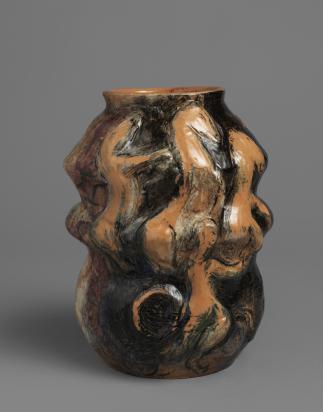
Marc CHAGALL, Elijah’s Chariot (Le Char d'Élie), 1951, red clay, decorated with slips and oxides, underglaze, 12 5/8 x 8 1/16 in. (32 x 20.5 cm), Private collection © Fabrice GOUSSET/ADAGP, Paris, 2026

Marc CHAGALL, Etude pour le vase Le Char d'Elie (Etude pour le vase Le Char d'Elie), 1951, 26 3/16 x 20 1/2 in. (66.5 x 52 cm), Private collection © ADAGP, Paris, 2026
